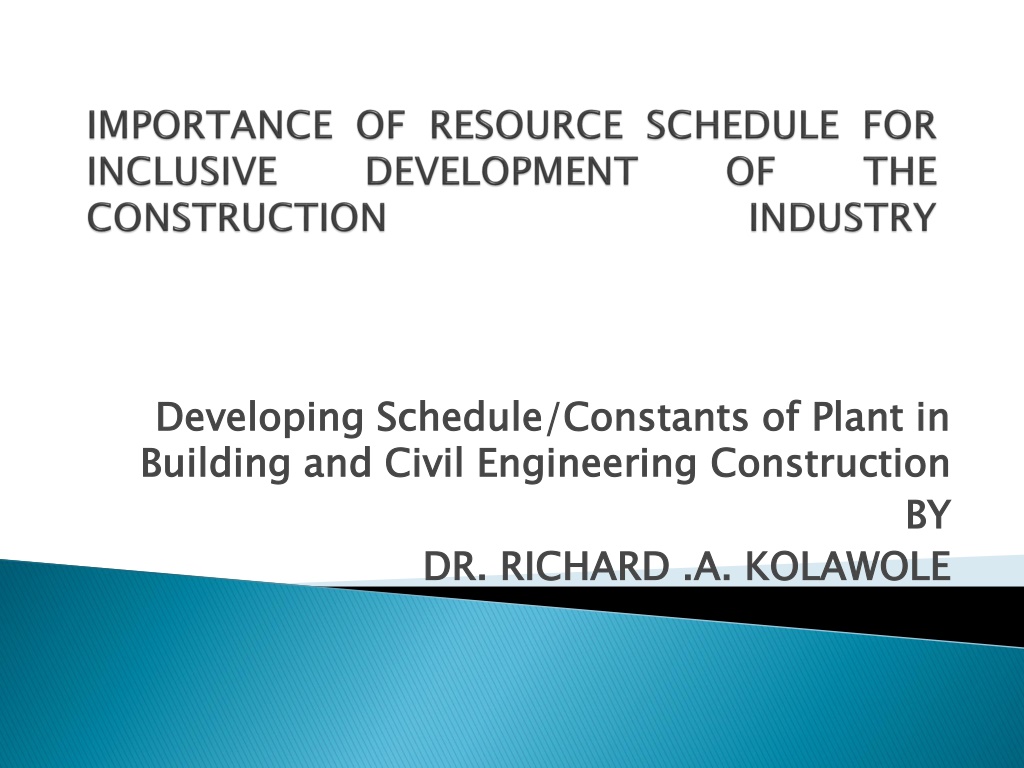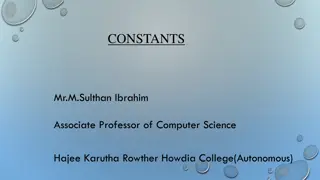Understanding Plant Constants in Construction Engineering
This academic piece delves into the significance of plant constants in building and civil engineering construction projects. It discusses the necessity of accurate quotes, reliable quantities, and standards for labor and plant to achieve efficiency and cost-effectiveness. The content emphasizes the importance of adapting to site-specific conditions, innovative management techniques, and boosting productivity. It also elaborates on construction plant schedules, operator efficiency ratings, and the role of heavy machinery in construction work.
Download Presentation

Please find below an Image/Link to download the presentation.
The content on the website is provided AS IS for your information and personal use only. It may not be sold, licensed, or shared on other websites without obtaining consent from the author. Download presentation by click this link. If you encounter any issues during the download, it is possible that the publisher has removed the file from their server.
E N D
Presentation Transcript
Developing Schedule/Constants of Plant in Building and Civil Engineering Developing Schedule/Constants of Plant in Building and Civil Engineering Construction Construction BY BY DR. RICHARD .A. KOLAWOLE DR. RICHARD .A. KOLAWOLE
According to Okoye, Ngwu and Ugochukwu (2015) development projects or make exact quotes with no accessible constants. While Wood (1976) reasons that work or plant constants for setting up the expense of work in the Bills of envisioned or thought. it is trying to draw reliable Quantities need not be speculated,
It thus becomes indispensable for the construction professional not only to have a complete understanding of skills, composition accomplish a task at shorter duration and decreased expense and this can only be possible standards for labour and plant generally given as constants (Okereke, 2002). the necessary the in but also of to each determine skill ideal order to through the use technological
However, taking into account the distinctions of each building site as far as conditions, social and social fluctuations in the degree of innovative and the nature of accessible suggested organization standards 2015). climatic machines that should (Okoye, and each establish Ngwu materials, construction its & it is own Ugochukwu,
increase productivity of labour; Objective tendering; Rational use of available resources; Adaptation of more progressive management techniques. in individual and collective
Plant literature compilation In-house data
Construction of productivity and may be expressed as a quantity of hours per unit (or minutes or days per unit) or unit per hour (or unit per minute or day). Construction Plant Plant Schedules/Constants Schedules/Constants are a guide Rating the indicates how efficient an operator is in comparison to some of his average fellow workers. Rating Factor efficiency Factor -This is expressed as a percentage of of representative operator, which Construction equipment Excavators, Cranes, Dumper, Hoist etc Construction Plants Plants refers to heavy machinery and used during construction work i.e
Work Study Is particularly measurement Work study techniques are: time study, motion study, fatigue study and method study. Since this paper is not interested in investing factors that affect the efficiency and economy of a situation being reviewed in order to standard time required to complete work I will be focusing on time Work Study a generic term method for those study techniques and for work effect improvement, but to establish time study study
Time observing and measuring plant/labour output using a timing device (stop watch) to establish the time required for completion of the work. The main objective is to determine by direct observation of plant output in a specific task and hence establish the standard time. Time Study Study is a structured process of directly
In time study of Construction Plant, it may not be possible to study machine time solely because plant operation includes manual, mental and machine times Manual handling of tools, machines and materials. Mental time denotes time taken by the worker for thinking over some operation Machine time refers to time taken by the plant in doing its share of work time involves three operations, i.e.
Observe the process your study begins by simply observing Decide on the fixed beginning and ending point Define action endpoint (EP) and terminal point (TP). Endpoint of one action is beginning of next Break the process into steps and determine their beginning and end point
Record your data Number of observations will depend on Accuracy desired Confidence desired Data variability Note Outliners are to be neglected Note
Elemen t t A A B B C C D D E E Elemen Average Observed Time Average Observed Time 1 1 2 2 3 3 4 4 5 5
Now that you have recorded all the times, its time to analyse them and do a little math to arrive at a determination of the average time for each step. Adjust the observed time by rating factor to obtain normal time for each element Add the suitable allowances to compensate for fatigue, personal needs, contingencies etc. to give standard time for each element. Compute allowed time for the entire job by adding elemental standard times considering frequency of occurrence of each element.
Make a detailed job description describing the method for which the standard time is established. Test and review standards wherever necessary.
Developing output of a Concrete mixer of 200 litres capacity per day Assuming that the average observed time for batching 2.30mins with a rating of 120% .allowance of 10% is allowed for the operation. The observed time for adding water and mixing in the drum is 1min and observed time for discharge is 1/2min. what is the Mixer output? Developing output of a Concrete mixer of 200 litres capacity per day material into a Concrete Mixer is Solution Observed Time = Rating Allowance 2.30mins 120% 10% = =
Solution Observed Time = 2.30mins Rating = 120% Allowance = 10% Normal Time = Observed Time x ?????? 2.30 x 100 Add Allowance = 2.76 x Standard time = Normal time + Allowance = 2.76 +0.276 = 3.036mins Solution = 100 120 = 2.76mins 10 100 = 0.276mins
Therefore, total time required for one batch of concrete =3.036 +1 +0.30 = 4.34mins per batch In a day of 8hours there will be effective mixing for 7hours Number of batch in 1 hour = 60 4.34= 13.82 say 14 Number of batches in 7hours = 14 x 7 = 98 Consider 90% efficiency output per batch = 200 x 90 100=180 litres Therefore output = 180 x 98 =17640litres or 17.64m 17.64m3 3























